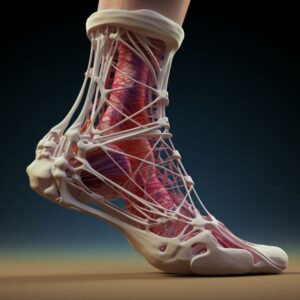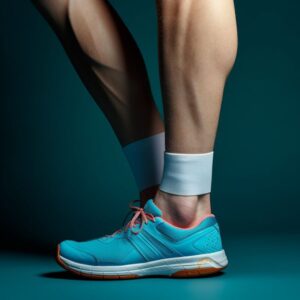The world of sports is a demanding one, not only in terms of physical prowess but also in the stress it places on our bodies, particularly our feet and lower limbs. Athletes, from professional to recreational, often face unique challenges related to foot health. Understanding the connection between sports injuries and podiatry is crucial for maintaining peak performance and preventing long-term damage. In this comprehensive guide, we’ll explore common sports injuries, their impact on foot health, and expert advice from podiatrists to keep athletes running strong.
Common Sports Injuries Affecting the Feet

Ankle Sprains:
A common occurrence in various sports, ankle sprains typically involve the stretching or tearing of ligaments around the ankle, often caused by a sudden twist or roll of the foot.
Podiatrist’s Advice: Immediate evaluation, rest, and a structured rehabilitation program are essential to prevent chronic instability and recurrence.
Plantar Fasciitis:
Inflammation of the plantar fascia, a band of tissue connecting the heel to the toes, causing heel pain, often aggravated by running or other high-impact activities.
Podiatrist’s Advice: Proper footwear, stretching exercises, and orthotic inserts can alleviate stress on the plantar fascia and promote healing.
Stress Fractures:
Tiny cracks in bones, often caused by repetitive stress on the feet, common in runners and athletes who participate in sports that involve frequent foot strikes.
Podiatrist’s Advice: Adequate rest, a gradual return to activity, and biomechanical assessments to identify contributing factors and prevent further stress fractures.
Achilles Tendonitis:
Inflammation of the Achilles tendon, the thick band of tissue connecting the calf muscles to the heel bone, particularly prevalent in runners and athletes with sudden increases in activity or training intensity
Podiatrist’s Advice: Eccentric strengthening exercises, proper footwear, and gait analysis to improve tendon strength, prevent overpronation, and reduce stress on the Achilles tendon.
Shin Splints:
Pain along the shinbone caused by inflammation of the muscles, tendons, and bone tissue in the lower leg, often aggravated by running or other high-impact activities.
Podiatrist’s Advice: Footwear assessment, orthotic support, and a gradual progression in training intensity to prevent further inflammation and allow for proper recovery.
Metatarsalgia:
Pain and inflammation in the ball of the foot, often aggravated by high-impact activities or wearing shoes with inadequate support.
Podiatrist’s Advice: Cushioned footwear, metatarsal pads, and gait analysis to alleviate pressure on the metatarsal bones and prevent further irritation.
Expert Advice from Podiatrists: Keeping Athletes in the Game
Proper Footwear Matters:

Podiatrists emphasise the significance of wearing appropriate footwear for specific sports. Ill-fitting shoes or those lacking proper support can contribute to a range of foot and ankle issues.
Custom Orthotics for Performance Enhancement:
Many athletes benefit from custom orthotic inserts designed to address individual biomechanical imbalances, such as flat feet or overpronation. Podiatrists can conduct gait analysis to determine the specific needs of an athlete’s feet and provide personalised orthotics for optimal support and performance.
Preventive Measures:
Regular check-ups with a podiatrist can help identify potential issues before they escalate into injuries. Preventive care may involve strengthening exercises for the foot and lower leg muscles, flexibility routines to improve range of motion, and gait analysis to identify any biomechanical abnormalities that could contribute to injuries.
Rehabilitation and Recovery:
In the event of an injury, proper rehabilitation is essential to restore function and prevent recurrence. Podiatrists work closely with athletes to develop tailored recovery plans, including physical therapy, stretching routines, and a gradual return-to-play protocol to ensure a safe and effective return to sport. For more information on rehabilitation and recovery from sports injuries, please visit https://appliedmotion.com.au/podiatry-perth-cbd/
Biomechanical Assessments:
Understanding Your Feet’s Mechanics: Understanding an athlete’s biomechanics is crucial for injury prevention and performance optimisation. Podiatrists can perform detailed assessments to identify any irregularities in gait, foot structure, or muscle function that may contribute to injuries and provide personalised recommendations to address these imbalances.
Nutrition and Foot Health:
Fueling Your Feet for Performance and Recovery: Podiatrists can provide advice on nutrition to support overall foot health and promote healing. Nutrient-rich diets, particularly those rich in calcium and vitamin D, contribute to optimal bone health and recovery from injuries.
Footwear Advice for Different Sports:
Finding the Right Fit for Your Activity. Different sports place unique demands on the feet. Podiatrists offer tailored advice on footwear suitable for specific activities, whether it’s running shoes with proper cushioning and support for long-distance runs, basketball shoes with ankle stability and shock absorption for quick cuts and pivots, or soccer cleats designed for optimal traction and ball control.
Monitoring Training Loads:
Podiatrists can collaborate with athletes to monitor training loads, ensuring that the intensity and frequency of activities align with the individual’s foot health and overall well-being. This includes assessing the athlete’s training schedule, considering factors like rest days, recovery time, and gradual progression in intensity and duration to prevent overuse injuries.
Keeping Athletes on Their Feet, at Their Best

Maintaining foot health is as crucial as any other aspect of training. Podiatrists play a pivotal role in the prevention, diagnosis, and treatment of sports-related foot injuries, ensuring athletes can perform at their peak and minimise the risk of setbacks.
Athletes, regardless of skill level, can benefit significantly from incorporating podiatric care into their overall training regimen. Regular check-ups, personalised advice, and proactive measures to address potential issues can keep their feet in optimal condition.
By seeking expert advice and taking proactive measures, athletes can ensure their feet are well-supported for the demands of their chosen sports. As we navigate the intricate balance between pushing our physical limits and preserving our body’s well-being, let expert podiatrists be valuable partners in the journey toward sustained athletic excellence.
